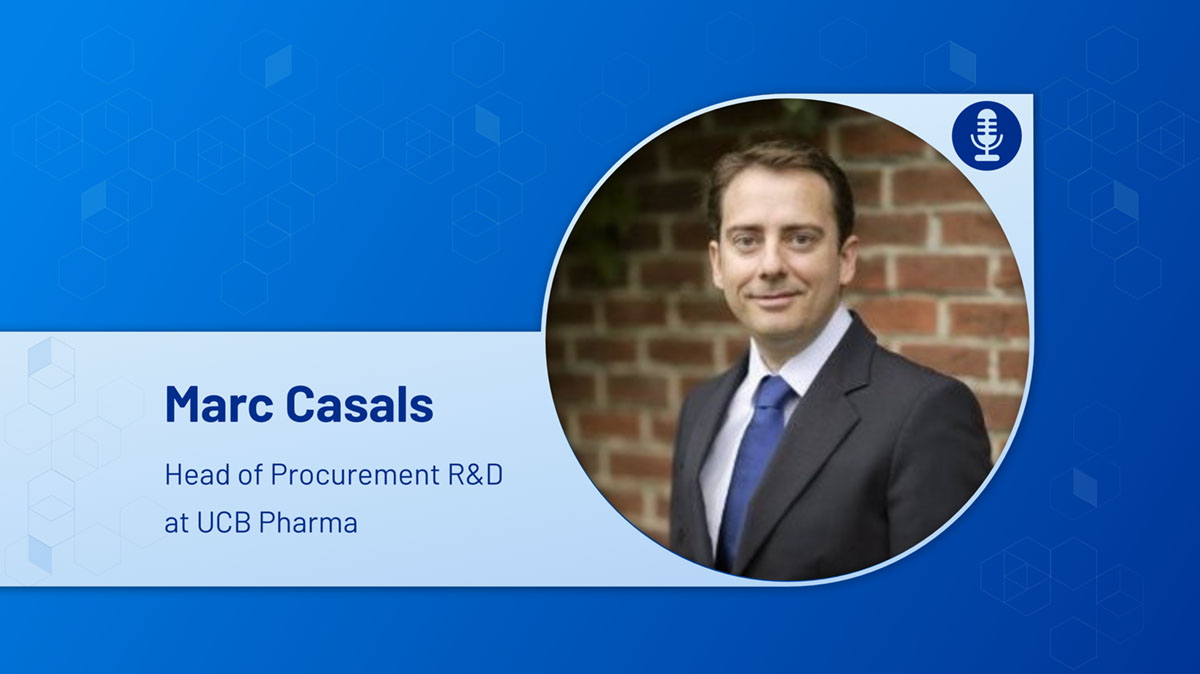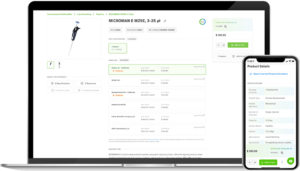Best Practice Procurement Strategies with UCB Pharma’s Marc Casals

Meeting with me today is Marc Casals, the head of global R&D procurement at UCB.
As a background, UCB is a global pharmaceutical company headquartered in Brussels. As a top 50 life sciences brand, UCB focuses primarily on research and development involving medicine centered on epilepsy, Parkinson's, and Crohn’s disease.
“As a top 50 life sciences brand, UCB focuses primarily on research and development involving medicine focused on Central Nervous System diseases as well as Immunology and Bone conditions such as RA, psoriasis and osteoporosis.”
But today we're not going to talk about science - at least not directly. Instead, we're going to talk about procurement, which has emerged as a key differentiator for most companies in this industry.
Marc, welcome, and thank you for joining us today.
Thanks a lot, James for offering me this possibility to be with you.
If you read the analysis from management consultants or news articles about procurement during the last 18 months, you'll see a lot of information about procurement as an ecosystem and many more about how technology is enabling procurement today. These are all really interesting concepts, but I wanted to go back to the source and learn from it. A best practices leader. Who's had some really exciting experience.
And Marc you probably don't know this, but you and I have a lot of things in common; like at university, I studied computer science and then I went and got my master's in business management. And early on, I was focused on consumer brand products and how you procure the supplies that you need efficiently to make sure that you're hitting your margin targets.
And then I made that similar transition to you, which was over in life sciences, R&D.
Back in 2005, you had made a pivot in your career from it to procurement when you were with Nike in Barcelona. Let's go back to that time, when you were tasked with building a procurement capability from scratch, how did you use your engineering background to prepare you for that role?
Indeed, the journey started quite a long time ago.
Setting the right procurement foundation is a fundamental piece in any business strategy. Procurement plays a crucial role from many angles, contributes in delivering value to the company strategy by providing efficiencies, managing risks, and being a steward of corporate sustainability agenda, but also plays a role towards internal stakeholders, suppliers, and even diverse local communities.
Having a supplier base properly segmented enables extracting value from key partners, a comprehensive Procurement policy backed up by a robust source-to-pay process enables optimal asset allocation and ensures the viability of the company. As simple and important as it is.
Last but not least, having highly committed colleagues striving for efficiency and innovation is the best asset that any Procurement team can have. At the end, all is about people.
In 2005, I had the opportunity to initiate this journey at Nike, starting discussions around procurement policy and the positioning of Procurement inside the organization. At that moment SAP SRM just started to roll out in the “pre-digital” world. The focus was in optimizing cash flow but also supplier consolidation and delivering efficiencies. At a later stage, the function evolved integrating a structured strategic sourcing process, adding supplier management methodology, and monitoring supply disruption risk.
Goodyear is a manufacturing company with large spend in capital expenditures, our efforts in Procurement were focused in optimizing the balance sheet and extricate costs from operations in a very volatile market impacted by the euro crisis in 2012.
That was some time ago in different industries than where I am now, but the procurement principles are very common between the 3.
“Setting the procurement foundation for an organization is a fundamental piece of the business strategy.”
Yeah, Marc. That's really interesting. I remember that time too. Where, when you talk about SAP and it was a lot of money to do those types of things. And it was almost overwhelming around how much effort it is to do that work. And I think what you had talked about was just that it's like setting the foundation and doing small pieces of it.
So was there a certain part of that technology that you had to sell people on to, to say, hey, we need to really digitize and get to the next level on this part of the business?
We focused on the SAP core system enabling the creation of purchase orders, which was not an easy platform to work with, user experience was rather poor, it did not play in our favour. We were not even discussing analytics at that stage, it was just about setting a procure-to-pay foundation.
All technology was on-premise; cloud did not exist at the time. So we had to treat our core systems like gold, in a dedicated data center, with dedicated access, our own air conditioning, dedicated power supply, and backups. And as you say, the cost of those licenses was a fortune. I remember one of the first questions from senior management was “what savings are you guys going to deliver to fund all this infrastructure?” That has changed a lot since then.
Yeah, it’s funny too, as I remember working with a company and they had an on-premise solution for their whole data center and the main internet connection - the T1 line that went into the data center - had gotten cut. They said, oh, what about the disaster recovery line? That got cut too. How did that happen? They took the two cables and they laid them next to each other and even though one was AT&T and one was Verizon, whoever was digging said it'll save us a couple of bucks if we just lay there next to each other,...we only have to dig one ditch and it was one cable in.
When someone was landscaping they accidentally cut everything and the site was down for several days. But it's just interesting, the on-premise challenge versus the cloud now is completely different.
At that moment I remember we worked with a company called MCI WorldCom, which went bankrupt in 2002, when I was just married and in honeymoon. I remember I was about to enter in the Disney park in Orlando when the General Manager called me: “When this it going to be fixed? I will start sending people home” at that moment I realized how critical an internet connection can be, the importance to have critical suppliers correctly identified and with its respective risk mitigation plan in place.
And I remember at the time when that happened, they said, we used to run this business on paper and a pen. Go take an order and go do your work. And so you're right all of a sudden you get this technology, it's hard to convince people to get on it. And as soon as there's a disruption, you have to get over that first hurdle to say this is providing a lot of value.
So one of the things that, especially when you think about Nike and Goodyear, there's a lot of focus on supply chain around being able to make sure that you're efficiently bringing in the raw materials and those types of things.
And especially within life sciences. If we look at what's been going on in the last 18 months, have you seen any similarities in your previous experience around managing the supply chain, from a procurement standpoint, versus life sciences?
The key difference is the product lead time and the role of the consumer in the decision-making process.
In life sciences, we are discovering molecules that will hit the market in potentially 10, 15 years from now if everything goes fine. The priorities are to manage a rich pipeline and ensure the molecule progresses along the value curve as fast as possible. The shorter you can reach the market, the better since the company will be able to capitalize higher returns before loss of exclusivity.
Nike and Goodyear are fast-moving consumer goods with shorter product lead times and less regulated markets than pharma. Nike lead time can be around 9-12 months, product placement at stores and its availability impact consumer decision, and switchability is usually high yet brands like Nike and Adidas have very loyal communities. Tyre market is very complex, competition has increased dramatically with new Asian brands entering in the market, in general terms brand loyalty is low and purchasing decision is driven by price and availability at point of sales.
In Pharma sales are driven by physician prescription, the consumer has a role to play only in OTC drugs.
I think that's a really great point.
And I remember at Pepsi, when I first joined, the big initiative was running out of stocks and it was for that same reason that you just brought up, which was if the consumer is standing in front of there and they have a choice between Pepsi and Coke and the Pepsi is off the shelf, they're just going to pick the Coke.
Same thing with shoes and tires. But you're right, we can't go to the doctor and say, what medicine do you have available? And like oh, this one's out of stock, let's just go with this other one. It's typically for a very specific indication and concern.
And also the impact of a disruption in pharma by not having the right medicine could be a life-threatening event for the patient, especially in severe chronic diseases. If the patient is not able to continue the treatment it will surely negatively impact the quality of life. Therefore supply chain excellence in pharma is non-negotiable.
I completely agree.
So focusing back on UCB, you talked about the lead times to get to that product. And one of the things that UCB is really focused on is enabling the scientists, having faster science, and being able to reduce that still long lead time.
So can you talk about, how is UCB or how do you handle your role in achieving that goal of being able to produce faster science?
One of the key challenges we noticed by working with scientists is how much time they’re spending in back-office tasks like ordering, warehousing, (and) attending calls from suppliers. In (the) words of the head of science, “we hire the best scientists because we expect them to run the best science 100% all the time”. Scientists shall not spend 5%-10% of time in back-office related work, which is the reality in some cases, still.
“One of the key challenges that we noticed, by working with scientists, is how much time they’re spending back-ordering, back-office tasks like ordering, warehousing, (and) attending calls from suppliers. In (the) words of the head of science, if we hire the best people it is because we expect to run the best experiments 100% of their time, not only 90% and 10% being distracted by other things.”
Digital Procurement could help to become more efficient in the ordering process and save valuable time for scientists. Starting from an enhanced, human-centric user interface but also estimating the order delivery time and providing information about where the order is at any moment in time.
There are not many companies out there that I've talked to that really put that much emphasis on the scientist and saying, a hundred percent productivity...it’s a pretty high bar.
If you think about the procurement side, are there other things that UCB is doing to really try to remove any other barriers from the scientist to make sure that they're focused on the science?
Having the right stock at the right place at the right time, leveraging stock rotation information is key to enable experiments that need immediate access to the reagents, solvents, plasticware (and) glassware. Ensuring there’s a sufficient buffer to keep science moving in times of turbulence like COVID, moving more and more towards predictive stock management through cognitive inventory management systems will be a must in the Lab of the Future stock room.
The complexity of Lab supplies is driven by the high variety of SKUs used by scientists, currently, we have between 13,000 and 14,000+ SKU’s in our labs worldwide. Rationalization and harmonization in this area is important but must be balanced with providing choices to scientists when running their experimentation.
It is a challenge — there's a lot of SKUs, there's a lot of scientists, there's a lot of stakeholders...similar to, I feel like, when you embarked on SAP - that was a giant hurdle to tackle at the time, as well.
So what are some of the tools or technology that you're looking at to help with forecasting lab supplies, managing 13,000 stock items? What are some of the technologies that you're enabling the scientists with?
That is still a work in progress. We are using different platforms, the majority of our data comes from SAP. We rely on Qlik Sense dashboards to visualize data, which is extensive because of the massive amount of orders coming through every year. We also work with Tableau software integrated in ZAGENO, with a granular view in subcategories and other vendor reports. Excel still plays a role when retrieving information from some suppliers.
As you're going through this can you talk a little bit about how that transformation from the scientist's perspective was handled? Are there certain expectations or ways that you have to communicate with them differently?
The message from the scientist is very clear: “We want what we need, when we need it and if possible, at the right cost. What happens in the backstage is not of our business”.
“...the message from the scientist is very clear. We want what we need, when we need it...and if possible at the right cost. But time is critical.”
We learnt the lesson during COVID-19 and Brexit. Our labs were nearly disrupted by supply chain issues, impacted by stock depletion, it required a massive effort from our colleagues in facilities, my colleagues from procurement, partners, and scientists to revert the situation, working 24x7 during 2 months, we will never forget those exhausting moments.
Availability is of utmost importance, cost comes at the second or third place because specs and quality are also very important. Sustainability is an emerging purchasing criteria, with increasing weight progressively impacting scientists' choices on lab consumables and equipment.
Suppliers quite often offer alternatives, but not everything works; we need to perform tests and quality checks which require time and effort.
It's really interesting because when you think about traditional procurement, it's typically focused on cost savings, supplier management, financial controls, and those types of things. When I listen to you speaking right now you talk about the scientist and the right product at the right time and ideally at the right price.
It's almost the opposite of traditional procurement. I don't know if you see it as much as I or others notice it; it's a very unique position that you're in.
When you came into UCB, was that the culture here? Is this something you helped instill?
Requests coming from scientists have not changed, they are looking for availability, quality, and speed. Yet the technology is evolving and now we know that we can look into solutions like ZAGENO for quick turnaround of the products and still realize savings, which is the DNA of the procurement function. There are opportunities to leverage cost savings, deliver a better user experience and ensure availability. And when these three stars are aligned, this is how science benefits from procurement.
There's always a challenge; you get to a milestone and then they immediately ask you to do more...
At Nike, we called it “There is no finish line”
It's exactly how this feels and especially as a moving target, when you think about R&D, for example...in Pepsi, there was a raw material provider that built a factory across the street from the manufacturing plant. I could see it from the parking lot and their number one customer was obviously Pepsi. And they had other customers obviously, but they did it strategically because they knew they're going to produce plastic bottles for a long time for one account.
But with R&D it's a lot different because you're right, there are some consumables that you use over and over, and that makes sense. But there's still this huge long tail where your suppliers change constantly. And the scientists are asking for new suppliers; they're trying to be innovative as well and create a new medicine; they need to find innovative suppliers.
So can you tell me about how you manage the needs of the scientist, where they want to have a lot of different choices and availability and there's constant change around who they're ordering from?
Yes, there is a base of around 500-700 products that are absolutely critical in the labs and are recurrent, the strategy is stockpiling or buffering.
We also need an agile ordering system to cope with new projects entering in the pipeline which require new consumables, and this can change very quickly. Scientists cannot wait three weeks for the reagents to come.
Ordering systems must cope with uncertainty driven by project cancellation or acceleration of high potential molecules. Market instability is a new variable to take in the equation.
“...there is a base of around 500-700 products that are absolutely crucial in the labs. On top of that we need to have an agile ordering system to cope with the emerging needs.”
Now you mentioned portfolio reviews. So you're looking at the different projects that are coming through the pipeline. And in my experience, there's usually a lot of decisions that go into what drugs continue and what don't. There's obviously a cost of commercial impact and an unmet medical need; there's a lot of different criteria that fall into that.
Are those discussions that you and your team are a part of, around understanding what medicines are coming through, what's getting approved...any kind of changes as far as strategies around where UCB wants to invest in different sciences.
UCB embarked in Gene Therapy as a new modality some time ago, shifting from treating the symptoms to finding a cure for certain diseases, especially in monogenic alterations in CNS. The strategy of the company is to lead in 5 patient subpopulations by 2025, in 2022 we are entering into a new phase of our strategy called “Breakthrough and Lead” with important milestones such as the launch of our new approved drug Bimzelx.
Okay. So we've talked a lot about getting scientists 100% percent productive, a very ambitious goal, which I love. We talked about having the right products at the right availability at the right time for them. We've talked a little bit about how you’ve got to forecast what lab supplies you need into the future. And then, where the business is changing.
We hear a lot of these terms around the lab of the future. And a lot of technology is going to enable the lab of the future. But in your own words, how would you describe the lab of the future, and what does that mean to you?
It’s a concept that has been there for quite a long time.
First of all, we have the sustainability angle. Labs of the future will consume less water, less resources, (and) less energy than the current lab. How are we going to reach there? Technology will be the enabler through (the) internet of things, new technologies that can track asset utilization and control the stock items on the shelves, triggering automatic orders. Similar concept as the Amazon Go stores.
Lab of the future means:
- Sharing resources amongst pharms companies / biohubs
- Sustainability in the lab – green labs
- Integration of systems enabled by cloud
- Smart equipment interacting with each other
Those are four megatrends that are already happening but we will see a big acceleration the close future.
Companies will think twice before purchasing equipment, instead, they will have access to central hubs in which slots can be booked to perform studies in a kind of co-working/co-science space.
“1) Sharing resources, 2) Sustainability, 3) Integration of systems, and 4) Smart equipment talking to each other. Those are four megatrends that are already happening.”
I think the term lab of the future it's this big, broad topic. It's like big data or analytics, everyone's talking about it is this huge concept, but then as soon as you start breaking it down it's really complicated and it's something that will take years and years.
Thank you so much again, for the great discussion and I’m happy that we share the same experiences in Pepsi and Nike.
Be vigilant; all the best for you and your families.


